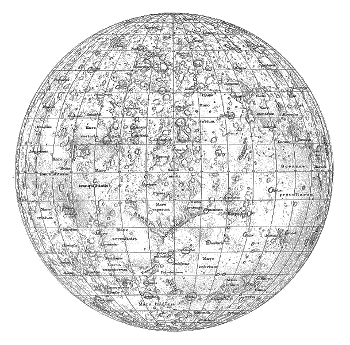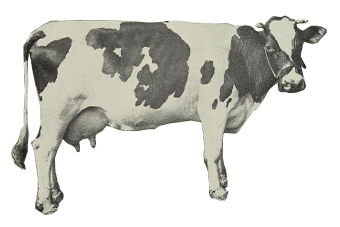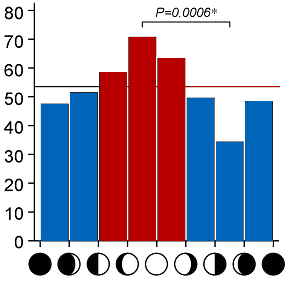The Lunacy of the Cows
October 13, 2016
When doing
experiments, it's important to eliminate
extraneous variables that might affect the outcome. That's why many experiments are done in a
vacuum to remove
reactions with
air, such as
oxidation, and other experiments are done at a constant
temperature. When elimination of such variables is inconvenient or impossible, you can correct the data according to a
model of their affect. In an extreme example of correction that I've seen, a
thermochemist doing
combustion calorimetry of
organic chemicals sealed in
plastic bags corrected for the small
volume of air sealed in the bags with the chemicals.
Sometimes experiments aren't possible, so you do careful
observations instead. In such cases, extraneous variables can't be controlled, and you might not even realize what the extraneous variables might be. When information is obtained by an
Internet survey,
Selection bias might cloud the results, since the
cohort of people responding to the survey are the ones who normally visit your
website.
In two previous articles (
General Lunacy, August 9, 2013 and
Moonstruck, April 16, 2015, I reviewed many of the known and supposed
biological effects of the
Moon.
Breeding of the scallop,[1] the population of several species of flying insect,[2] and the human menstrual cycle[3-4] all show a lunar periodicity.

(An 1881 map of the Moon, from the Andrees Allgemeiner Handatlas, 1st Edition, Leipzig, Germany, p. 4, via Wikimedia Commons.)
Things are not as clear cut when it comes to the Moon's affect on
human behavior and other human functions. Although we have the word,
lunatic, a word derived from the
Latin word for Moon (Luna), and other lunar
folklore, are humans really influenced by the
full Moon?
There's an
old wives' tale that more
births occur at the time of the
full Moon, but careful examination shows that such a
correlation is not present.[5] In particular, a study of 8,142 natural births (those not induced by
drugs or
Caesarean sections), from 1974 to 1978 at the
University of California, Los Angeles hospital, showed no correlation with
lunar phase.[6]
Humans are a complex study subject. Unlike
laboratory mice, they have a
varied diet, a varied
lifestyle, and may even take a variety of
over-the-counter drugs and
prescription drugs, all of which might add enough
noise to this birth study to mask a slight tendency in humans to give birth near the full Moon. Since the
gestation period for a
laboratory mouse is just twenty days, we won't find any correlation with lunar phase there.
However,
cows have a gestation period that closely matches humans, about nine months.
Veterinary scientists at the
University of Tokyo (Tokyo, Japan) and
Kitasato University (Aomori, Japan) have just
published a study of the Moon's affect on spontaneous deliveries in
domestic Holstein cows.[7-8] As they report in a
paper in the
Public Library of Science (PLoS), the influence of the phase of the Moon is clearly seen.

Holsteins are the most common dairy cow in the United States.
(Via Wikimedia Commons.)
As paper
co-author,
Tomohiro Yonezawa, an
associate professor in the
University of Tokyo Graduate School of Agriculture and Life Sciences, explains, the Moon's influence might have been masked in human studies since
"...Multiple factors, such as the mothers' nutrition, social environment, and genetic background could disguise the moon's influence. However, cows may provide a good model for teasing apart the lunar effect from other factors that also influence birth."[8]
The researchers used
data on 428 spontaneous, full-term deliveries at a private
farm in
Hokkaido, Japan, in a three-year period between September, 2011, and August, 2013.[7-8] They found that the birth
frequency increased uniformly from the
new Moon to the full Moon, and it decreased until the
waning crescent phase.[7] There was a
statistically significant peak in the period around the full Moon as compared with the other
lunar quarters (see graph).[7]

Birthing trend with lunar phase for Holstein cattle.
(University of Tokyo image by Yonezawa et al., colorized.)
Interestingly, the Moon's affect was more apparent for cows who had delivered calves previously (multiparous) than those who had not previously given birth (nulliparous).[7-8] Yonezawa cautions that a
larger sample size is needed before a firm conclusion can be reached, that the "...findings do not immediately hold true for human births and we still don’t know why the number of calves delivered increases around the full moon."[8]
References:
- James Mason, "A possible lunar periodicity in the breeding of the scallop, Pecten maximus (L.)," Journal of Natural History, ser. 13, vol. 1, no. 9 (1958), pp. 601-602.
- W. Danthanarayana, "Lunar Periodicity of Insect Flight and Migration," Proceedings in Life Sciences (1986), pp. 88-119.
- Winnifred B. Cutler, "Lunar and Menstrual Phase Locking," American Journal of Obstetrics and Gynecology, vol. 137 (1980), p. 834.
- Winnifred B. Cutle, Wolfgang M. Schleidt, Erika Freidmann, George Preti and Robert Stine, "Lunar Influences on the Reproductive Cycle in Women," Human Biology, vol. 59, no. 6 (December 1987).
- Margot, Jean-Luc, "No Evidence of Purported Lunar Effect on Hospital Admission Rates or Birth Rates," Nursing Research, vol. 23, no. 1 (March, 2015). This is an open access article with a PDF file available at this URL.
- G.O. Abell and B. Greenspan, "Human births and the phase of the moon [Letter]," New England Journal of Medicine, vol. 300 (January 11, 1979), p. 96, DOI: 10.1056/NEJM197901113000223. An abstract is available here.
- Tomohiro Yonezawa, Mona Uchida,Michiko Tomioka, and Naoaki Matsuki, "Lunar Cycle Influences Spontaneous Delivery in Cows," PLoS ONE, vol. 11, no. 8 (August 31, 2016), Document no. e0161735, doi:10.1371/journal.pone.0161735. This is an open access publication with a PDF file available here.
- Lunar cycle affects timing of birth in cows, University of Tokyo Graduate School of Agricultural and Life Sciences Press Release, September 1, 2016.
Permanent Link to this article
Linked Keywords: Experiment; extraneous variable; vacuum chamber; vacuum; chemical reaction; air; oxidation; temperature; mathematical model; thermochemistry; thermochemist; combustion; calorimetry; organic compound; organic chemical; plastic bag; volume; observation in science; Internet; opinion poll; survey; selection bias; cohort; website; biology; biological; Moon; breeding in the wild; scallop; species; pterygota; flying insect; human menstrual cycle; lunar; periodic function; periodicity; map; Andrees Allgemeiner Handatlas; Leipzig, Germany; Wikimedia Commons; human behavior; lunatic; Latin; folklore; full Moon; old wives' tale; birth; correlation; pharmaceutical drug; Caesarean section; University of California, Los Angeles hospital; lunar phase; laboratory mouse; laboratory mice; diet; lifestyle; over-the-counter drug; prescription drug; statistical noise; gestation period; cattle; cow; veterinary medicine; veterinary scientist; University of Tokyo (Tokyo, Japan); Kitasato University (Aomori, Japan); scientific literature; publish; domestication; domestic; Holstein Friesian cattle; Holstein cow; academic publishing; paper; Public Library of Science; dairy cattle; dairy cow; United States; author; Tomohiro Yonezawa; associate professor; University of Tokyo Graduate School of Agriculture and Life Sciences; social environment; gene; genetic; data; farm; Hokkaido, Japan; frequency; phases of the moon; waning crescent phase; statistical significance; statistically significant; lunar quarter; sample sizes for hypothesis tests.